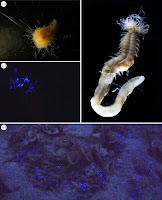 |
| Polycirrus onibi Jimi, P. aoandon Jimi, & P. ikeguchii Jimi, in Jimi, Bessho-Uehara, Nakamura, Sakata, Hayashi, et Ogoh, 2023 DOI: 10.1098/rsos.230039 |
Bioluminescence, a phenomenon observed widely in organisms ranging from bacteria to metazoans, has a significant impact on the behaviour and ecology of organisms. Among bioluminescent organisms, Polycirrus, which has unique emission wavelengths, has received attention, and advanced studies such as RNA-Seq have been conducted, but they are limited to a few cases. In addition, accurate species identification is difficult due to lack of taxonomic organization. In this study, we conducted comprehensive taxonomic survey of Japanese Polycirrus based on multiple specimens from different locations and described as three new species: Polycirrus onibi sp. nov., P. ikeguchii sp. nov. and P. aoandon sp. nov. The three species can be distinguished from the known species based on the following characters: (i) arrangement of mid-ventral groove, (ii) arrangement of notochaetigerous segments, (iii) type of neurochaetae uncini, and (iv) arrangement of nephridial papillae. By linking the bioluminescence phenomenon with taxonomic knowledge, we established a foundation for future bioluminescent research development. We also provide a brief phylogenetic tree based on cytochrome c oxidase subunit I (COI) sequences to discuss the evolution of bioluminescence and the direction of future research.
Keywords: Polycirrus aoandon sp. nov., Polychaeta, Polycirrus onibi sp. nov., Polycirrus ikeguchii sp. nov., terebelliformia, bioluminescence
 |
| Polycirrus onibi sp. nov. |
Genus Polycirrus Grube, 1850
[New Japanese name: Hikari-Fusa-gokai-zoku]
Type-species. Polycirrus medusa Grube, 1850 [13].
Polycirrus onibi Jimi, sp. nov.
[Japanese name: Onibi-fusa-gokai]
Diagnosis. Polycirrus with transparent body wall, tentacles with subterminal red spots, mid-ventral groove from segment 3, notochaetae on segments 3–14, neurochaetae on segment 15 and following segments, type II uncini, nephridial papillae in anterior area of parapodia on segments 3–14.
Etymology. The new species name derives from the Japanese yōkai ‘onibi’. Onibi represents the soul of a deceased human or animal, manifested as a floating blue flame. It is often equated with the Will-o'-the-wisp. The blue–purple bioluminescence is reminiscent of this yōkai.
Polycirrus ikeguchii Jimi, sp. nov.
[Japanese name: Ikeguchi-fusa-gokai]
Diagnosis. Polycirrus with transparent body wall, tentacles with subterminal red spots, mid-ventral groove from segment 2, notochaetae on segments 3–19, neurochaetae on segment 17 and following segments, type II uncini, nephridial papillae in anterior area of parapodia, on segments 3–17.
Etymology. The species is named after Mr Shinichiro Ikeguchi. He is the former deputy director of the Notojima Aquarium, and he contributed to the discovery of the luminescence phenomenon of this species.
Polycirrus aoandon Jimi, sp. nov.
[Japanese name: Aoandon-fusa-gokai]
Diagnosis. Polycirrus with orange body wall, tentacles without subterminal red spots, mid-ventral groove from segment 3, notochaetae on segments 3–56, neurochaetae on segment 16 and following segments, type I uncini, nephridial papillae in anterior area of parapodia on segments 3–14.
Etymology. The new species name derives from the Japanese yōkai ‘Aoandon’. Aoandon carries a blue (= Ao in Japanese) lantern (= andon in Japanese). The blue–purple bioluminescence is reminiscent of this yōkai.
Naoto Jimi, Manabu Bessho-Uehara, Koji Nakamura, Masahiko Sakata, Taro Hayashi, Shusei Kanie, Yasuo Mitani, Yoshihiro Ohmiya, Aoi Tsuyuki, Yuzo Ota, Sau Pinn Woo and Katsunori Ogoh. 2023. Investigating the Diversity of Bioluminescent Marine Worm Polycirrus (Annelida), with Description of Three New Species from the Western Pacific. Royal Society Open Science. DOI: 10.1098/rsos.230039
phys.org/news/2023-03-newly-sea-worms-dark-creatures.html

